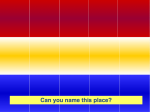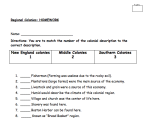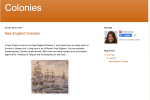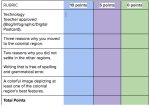Unit Goal
-
The student will demonstrate knowledge of the colonies and the factors that shaped colonial North America.
-
Similarities and differences between colonial economies, politics, and ways of life.
-
Physical and human characteristics of national colonial regions.
Unit Objective
-
Verbally identify 3 motives for exploration of the colonial regions; e.g., religion, expansion, trade, wealth with 80% accuracy
-
Distinguish between New England, Middle, and Southern Colonies by coloring and identifying the colonial regions on a map with 100% accuracy.
-
Understand the emergence of major regional differences in the colonies by completing a bulleted graphic organizer based on lecture notes with 90% accuracy.
-
Given a graphic organizer students will contrast the economies of the three major colonial regions: New England, Middle, and Southern with 80% accuracy.
-
Given a graphic organizer students will compare the impact of geography on the economies of the three major colonial regions. Understand how settlers’ backgrounds influenced their values, priorities, and daily lives.
-
Create a historical fiction blog or infogram or digital (postcard) that identifies unique traits of a colonial region and describes life in that region. Students projects will include:
-
Three reasons why you moved to the colonial region.
-
Two reasons why you did not settle in the other region.
-
Writing that is free of spelling and grammatical error.
-
A colorful image depicting at least one of the colonial region’s best features.
Background and Rationale
The purpose of this activity is to provide a comprehensive method to explore the development of the English Colonies three distinct regions by creating a historical fiction blog or postcard that identifies unique traits of a colonial region and describes life in that region based on class lecture and notes. The essential questions that will guide this lesson are: What are the three major colonial regions? What factors led to the development of the three regions?; How did the geography influence colonial development. The lesson is differentiated by visuals, simplified definitions graphic organizers and skeletal notes.
Lesson Objectives
Objective |
Bloom’s Verb |
|---|---|
|
Verbally identify 3 motives for exploration of the colonial regions; e.g., religion, expansion, trade, wealth with 80% accuracy |
Identifying |
|
Distinguish between New England, Middle, and Southern Colonies by coloring and identifying the colonial regions on a map with 100% accuracy. |
Identifying |
|
Understand the emergence of major regional differences in the colonies by completing a bulleted graphic organizer based on lecture notes with 90% accuracy. |
Understanding |
|
Given a graphic organizer students will contrast the economies of the three major colonial regions: New England, Middle, and Southern with 80% accuracy. |
Analyzing |
| Given a graphic organizer students will compare the impact of geography on the economies of the three major colonial regions. Understand how settlers’ backgrounds influenced their values, priorities, and daily lives with 80%accuracy. | Analyzing |
|
Create a historical fiction blog or (postcard) that identifies unique traits of a colonial region and describes life in that region. Students postcards will include:
|
Creating |
Bloom’s Taxonomy
Creating (Bloom’s highest level)
Curriculum Standards
NYS Social Studies
-
Standard 1: Students will: use a variety of intellectual skills to demonstrate their understanding of major ideas, eras, themes, developments, and turning points in the history of the United States and New York.
Common Core ELA
CCSS.ELA-Literacy.SL.7.1 Engage effectively in a range of collaborative discussions (one-on-one, in groups, and teacher-led) with diverse partners on grade 7 topics, texts, and issues, building on others’ ideas and expressing their own clearly.
CCSS.ELA-Literacy.SL.7.5 Include multimedia components and visual displays in presentations to clarify claims and findings and emphasize salient points.
Technology Integration (ISTE Standards):
1. Creativity and innovation: Students demonstrate creative thinking, construct knowledge, and develop innovative products and processes using technology.
-
Apply existing knowledge to generate new ideas, products, or processes
2. Communication and collaboration: Students use digital media and environments to communicate and work collaboratively, including at a distance, to support individual learning and contribute to the learning of others.
-
Communicate information and ideas effectively to multiple audiences using a variety of media and formats
3. Research and information fluency: Students apply digital tools to gather, evaluate, and use information.
-
Locate, organize, analyze, evaluate, synthesize, and ethically use information from a variety of sources and media
Learning and Innovation Skills (P21.org)
Think Creatively
-
Use a wide range of idea creation techniques (such as brainstorming)
-
Elaborate, refine, analyze and evaluate their own ideas in order to improve and maximize creative efforts
Work Creatively with Others
-
Be open and responsive to new and diverse perspectives; incorporate group input and feedback into the work
Information, Media, and Technology Skills (P21.org)
Information Literacy: Access and Evaluate Information
-
Access information efficiently (time) and effectively (sources)
Media Literacy: Create Media Products
-
Understand and utilize the most appropriate media creation tools, characteristics and conventions
ICT Literacy: Apply Technology Effectively
-
Use technology as a tool to research, organize, evaluate and communicate information
Life and Career Skills (P21.org)
FLEXIBILITY AND ADAPTABILITY
Be Flexible
-
Incorporate feedback effectively
INITIATIVE AND SELF-DIRECTION
Manage Goals and Time
-
Set goals with tangible and intangible success criteria
INITIATIVE AND SELF-DIRECTION
Manage Goals and Time
-
Set goals with tangible and intangible success criteria
-
Balance tactical (short-term) and strategic (long-term) goals
-
Utilize time and manage workload efficiently
Work Independently
-
Monitor, define, prioritize and complete tasks without direct oversight
SOCIAL AND CROSS-CULTURAL SKILLS
Interact Effectively with Others
-
Know when it is appropriate to listen and when to speak
-
Conduct themselves in a respectable, professional manner
Work Effectively in Diverse Teams
-
Respect cultural differences and work effectively with people from a range of social and cultural backgrounds
-
Respond open-mindedly to different ideas and values
PRODUCTIVITY AND ACCOUNTABILITY
Manage Projects
-
Set and meet goals, even in the face of obstacles and competing pressure
-
Prioritize, plan and manage work to achieve the intended result
Materials |
|---|
|
|
|
Flip Chart (New England, Middle and Southern Colonies) Click on the image |
|
Blog/Infographic/digital postcard Example: |
| Map Colored Pencils |
|
Rubric |
Thinking Routine
Zoom In thinking routine requires learners to pay close attention to detail and make inferences. Because it uses only sections of an image at one time. This routine will be used as the opening activity where students will be given four clues based on the middle colonies. Each clue will be displayed as the image on the Promethean Board. As the clues are provided a portion of a portrait of the middle colonies will be revealed to students. This will be a review of prior class discussion and notes based on the middle colonies.
Lesson Introduction
Students will discuss the Zoom In activity in pairs and report out their inferences as a whole group. This will provide a discussion of the previous class discussion of the northern colonies.
Lesson Procedures and Activities: (2 Days)
Students will complete a skeletal notes packet based on the Southern Colonial region. The bulleted notes packet coincides with a flip chart that provides a simplified overview of the southern colonial region along with illustrations to emphasize the content.
Notes will focus on lecture and class discussion. BIG IDEAS: The Southern Colonies had fertile soil and a long growing season. Cash crops like tobacco, indigo and rice were grown. Enslaved Africans were forced to do the work on plantations in this region. There were fewer towns and schools in this region. Plantations and farms were fairly spread out.
I will then introduce the blog/infographic/ digital postcard assignment to the class. We will go over the requirements of the postcard and the point based rubric. Students will be given explicit instructions and an example of what their final /Blog/Inforgram/digital postcard should look like.
Guided Practice
I will provide students with support/Rough Draft Template to write their Blog/Infographic/digital postcard.
Students will pretend that they are an American Colonist in the early 1700s. They will write a blog/ Infographic/digital postcard to a friend in Europe. The project the student selected to create will focus on describing a Colonial Region (New England, Middle, Southern) they have settled in and their reasons for doing so. It must contain:
-
Technology approved (infographic//Blog/Digital Postcard Etc. (10pts)
-
Three reasons why you moved to the colonial region, (10 pts).
-
Two reasons why you did not settle in the other regions, (10 pts).
-
Writing that is free of spelling and grammatical error, (10 pts).
-
A colorful image depicting at least one of the colonial region’s best features, (10 pts).
Independent Practice
Students will create their blog/Infographic/digital postcard independently, using their guided notes packet. Students will create a rough draft that will be edited by by a peer. They can use their note packet and key terms as references. Students will then create their final copy to be sent to the teacher upon completion
Lesson Closure
Students will complete an exit card that will ask them to give two facts about the southern colonies and if they have any questions.
Assessment

Formative Assessment: Homework-Determine students understanding of the 3 colonial regions. Students will be assessed through the completion of their note packet, on task behaviour and class participation.
Summative Assessment: Students will complete a blog/infographic/digital postcard based on the rubric provided. Using a rubric with the students will allow the students to become more thoughtful judges of the quality of their own work.
Student Copy of rubric.







